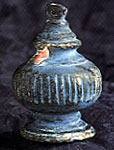 |
|
Maritime Asia
Exhibition:
|
19 July 2003
|
||||
| Last modified: 19 July 2003 |
 The
bronze weight shown on the right was found on the Longquan wreck (c.1400).
It is in the shape of a covered jar, but is solid (12cm high, and weighing 2.15kg).
It is thought to have been used for sounding water depth. Three weights of similar
shape and size were found on the Bakau
wreck (Chinese, early C15th)(1).
The
bronze weight shown on the right was found on the Longquan wreck (c.1400).
It is in the shape of a covered jar, but is solid (12cm high, and weighing 2.15kg).
It is thought to have been used for sounding water depth. Three weights of similar
shape and size were found on the Bakau
wreck (Chinese, early C15th)(1).
A tin weight found on the Royal Nanhai (c.1460), also 2.15kg, is shaped like the upper part of a pumpkin, with the hole pierced through the stem.
European sounding leads found on the Nuestra Senora de la Concepcion (Spanish, 1638) and the Hercules (Dutch, 1661) were of plainer design.
The use of a sounding weight by Chinese ships was described in 1117 AD: 'They also use a line a hundred feet long with a hook at the end, which they let down to take samples of mud from the sea-bottom; by its appearance and smell they can determine their whereabouts.'(2)
| Maritime Asia homepage |